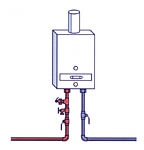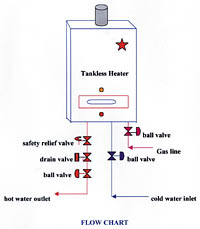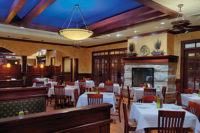Water heaters are used everywhere to supply hot water in residential and commercial buildings. A water heater is a closed vessel used to supply potable hot water. This water is heated by the combustion of fuels, electricity or other sources and withdrawn for external use at pressures less than 160 psig or a heat input of 200,000 Btu/hour. The water heater must include all controls and devices necessary to prevent water temperatures from exceeding 210 degrees F.

Types of Water Heaters
A water heater, based on construction, is classified as a storage tank water heater or tankless water heater.In a storage water heater, hot water is drawn from the top of the tank when the hot water tap is turned on. Cold water enters from the bottom of the tank to replace the hot water, and the cycle continues. As the water is heated constantly in the tank to maintain a temperature between 120-140 degrees F, energy is wasted when that hot water is not drawn from the tank and the hot water tap remains off. This loss of energy is called standby loss, and it represents about 10-20% of a household's water heating costs.
On the other hand, in a tankless water heater, cold water travels through a pipe into the unit, which is turned on only when water is required. This type of water heater is also called a demand water heater (or "instantaneous" water heater) as it operates on demand, and reduces the standby loss.
The remainder of this article will focus on the design, construction, installation, operation and maintenance of tankless water heaters.
Tankless Water Heaters
The tankless water heater, also known as an instantaneous water heater, has been used in Japan and European countries for many years. People started using tankless water heaters in the United States about 25 years ago. Presently, tankless water heaters can be found in this country for many residential and commercial applications.
A tank water heater produces potable water, but a tankless water heater produces potable water and hot water for heating a building. These water heaters are used for homes, offices, cottages, apartments, camps, restaurants, dishwashers, laundries, car washes and water heating for residential and commercial applications.
Design and Construction
A tankless water heater is designed to supply hot water on demand. The unit has a heating device that is activated by the flow of water when the hot water valve is opened. Once activated, the heater continues to heat the water at constant temperatures between 100 degrees and 140 degrees F, and delivers a constant supply of hot water.The heater has an efficiency rating ranging from 78-82%, and energy factors ranging from 0.69 to 0.80. On the other hand, the highest energy factor for a tank storage heater is 0.65. The tankless heater is normally designed with a flow capacity of 0.6 to 6.3 gpm, a maximum heat input of 600,000 Btu/hour, and a maximum temperature of 180 degrees F (certified by the American Gas Association).
Instantaneous water heaters are available in propane, natural gas or electric models. They are designed for many different applications and in a variety of sizes. A tankless heater with 125,000 Btu/hr may replace a 40-gallon storage tank heater, and one with an input of 165,000 Btu/hr will replace a 70-gallon tank heater.
Tankless heaters are constructed normally with stainless steel and aluminum. The heat exchanger is made of solid copper or solid brass, and the burners of stainless steel. Since hot water is not stored, mineral build-up and corrosion are minimal.

Installation
The installation of tankless water heaters is done in accordance with the local and state codes, rules and regulations. In the absence of such jurisdictional requirements, the recommendations of a manufacturer should be followed. In addition, National Fuel Gas Code NFPA 54 may be used for installation.This type of unit is designed for indoor and outdoor locations. Suitable vent piping to exhaust by-products of combustion to the outside environment should be used for indoor installation. Also, all pipe joints should be taped properly to prevent leakage around the joints. Proper space around the unit should be maintained for serving and operation. The following minimum clearances for combustible and non-combustible materials should be adhered to:
Top of Heater 36 inches
Back of Heater 0 inches
Front of Heater 24 inches
Sides of Heater 6 inches
Ground 12 inches
Safety Devices
The demand heater has many safety features, which include flame failure, boiling protection at 221 degrees F, overheat sensor at 207 degrees F, thermal fuse at 265 degrees F, automatic frost protection to -30 degrees F, combustion fan rpm check by integrated circuit system, over current protection by two glass fuses, remote control, and built-in anti-scald failure with remote control.
In addition, the heater must have a safety relief valve that is rated at 150 psi pressure and complies with the Standard for Relief Valves and Automatic Shutoff Devices for Hot Water Supply Systems ANSI Z21.22.
Operating Procedures
The operation of this type of instantaneous heater is very simple and can be operated with or without a digital remote control. The water temperature is adjustable from 96 degrees F to 140 degrees F with the main controller. The unit has the ability to check its own operation continuously. If a fault occurs, an error message will flash on the digital monitor of the remote controls. Technical service should be called for in the case of an over temperature warning, faulty temperature sensors, non-functioning solenoid valves, combustion fan failure, faulty flame sensing devices or scale build-up in the heat exchanger.Inspection and Maintenance
Although this water heater is designed for long life expectancy, the following regular inspections and maintenance tips are recommended for efficient operation:
- Clean the water heater annually. Keep the unit free from dust and debris, especially in and around the burner.
- Visually check the main burner flames. The burner should flame evenly over the entire surface with a clear, blue and stable flame.
- The vent system should be checked annually for blockage or deterioration.
- Keep the fan and electric motor free from dust and dirt, and clean them annually.
- Test the safety relief valve once every six months and make sure it is not leaking.
Conclusion
The main advantage of tankless water heaters is that they can produce an endless supply of hot water. Other appealing factors include easy operation, elimination of standby losses to lower operating costs, and a higher life expectancy than that of a tank heater (the average life of a tankless heater is 20 years, compared to 12 years for a tank heater).The disadvantage is that the demand heater's initial cost is more than conventional tank heaters. Also, the output of the heater limits the rate of heated water flow. Despite these disadvantages, tankless water heaters are very popular, and the demand for these heaters is steadily rising.

